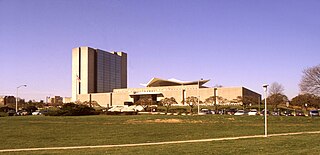
Achondrogenesis is a number of disorders that are the most severe form of congenital chondrodysplasia. These conditions are characterized by a small body, short limbs, and other skeletal abnormalities. As a result of their serious health problems, infants with achondrogenesis are usually born prematurely, are stillborn, or die shortly after birth from respiratory failure. Some infants, however, have lived for a while with intensive medical support.

Golgin subfamily A member 2 is a protein that in humans is encoded by the GOLGA2 gene.

General vesicular transport factor p115 is a protein that in humans is encoded by the USO1 gene.

Ras-related protein Rab-1A is a protein that in humans is encoded by the RAB1A gene.

Golgin subfamily A member 3 is a protein that in humans is encoded by the GOLGA3 gene.

Golgin subfamily A member 4 is a protein that in humans is encoded by the GOLGA4 gene.

ADP-ribosylation factor-like protein 1 is a protein that in humans is encoded by the ARL1 gene.

Golgin subfamily A member 5 is a protein that in humans is encoded by the GOLGA5 gene.

Golgin-45 is a protein that in humans is encoded by the BLZF1 gene.

GRIP and coiled-coil domain-containing protein 2 is a protein that in humans is encoded by the GCC2 gene.

Golgi resident protein GCP60 is a protein that in humans is encoded by the ACBD3 gene.

Golgin subfamily A member 1 is a protein that in humans is encoded by the GOLGA1 gene.

GRIP and coiled-coil domain-containing protein 1 is a protein that in humans is encoded by the GCC1 gene.

RAB6-interacting golgin also known as N-terminal kinase-like-binding protein 1 (NTKL-BP1) or SCY1-like 1-binding protein 1 (SCYL1-BP1) is a protein that in humans is encoded by the GORAB gene.

Inositol monophosphatase 3 also known as inositol monophosphatase domain-containing protein 1 (IMPAD1) is an enzyme that in humans is encoded by the IMPAD1 gene.

Giantin or Golgin subfamily B member 1 is a protein that in humans is encoded by the GOLGB1 gene. Giantin is a disulfide-linked homodimer.

The Golgi matrix is a collection of proteins involved in the structure and function of the Golgi apparatus. The matrix was first isolated in 1994 as an amorphous collection of 12 proteins that remained associated together in the presence of detergent and 150 mM NaCl. Treatment with a protease enzyme removed the matrix, which confirmed the importance of proteins for the matrix structure. Modern freeze etch electron microscopy (EM) clearly shows a mesh connecting Golgi cisternae and associated vesicles. Further support for the existence of a matrix comes from EM images showing that ribosomes are excluded from regions between and near Golgi cisternae.

Golgin A7 is a protein that in humans is encoded by the GOLGA7 gene.

Golgin A8 family member B is a protein that in humans is encoded by the GOLGA8B gene.

Janus kinase and microtubule interacting protein 2 is a protein that in humans is encoded by the JAKMIP2 gene.





















